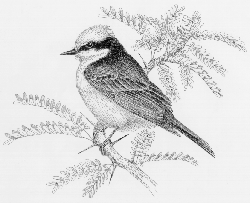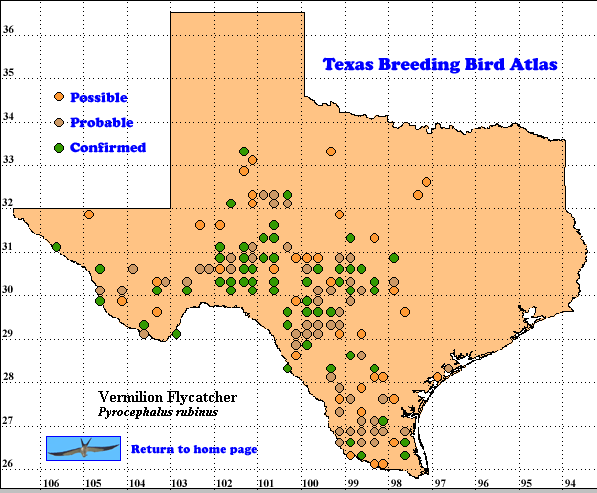Pyrocephalus rubinus
The Vermilion Flycatcher is a characteristic species of moist oases in the arid southwestern United States (Bent 1963, Oberholser 1974, Sexton 1999). This species is widely distributed from southwestern Texas, central Arizona, southern Nevada, and southern California southward well into South America (AOU 1998). At the northern and eastern limits of its expected breeding range in Texas it is somewhat irregular and isolated pairs are prone to periodic or episodic breeding attempts well outside the normal range.
Distribution: The breeding range of the Vermilion Flycatcher encompasses the southern two-thirds of the Trans-Pecos, the Edwards Plateau (as far north as Midland, the Concho Valley, and Abilene; as far east as Burnet and Travis counties), and most of south Texas (TBBAP data; Oberholser 1974, Tarter 1989, Paton and Zimmer 1996, Wauer 1996, Peterson & Zimmer 1998; Kelly & Sexton in press; F. Williams pers. comm.). The highest population densities in Texas are generally in the western Edwards Plateau and the northern portions of the south Texas brushlands (Sauer 1999). The eastern edge of the breeding range conforms to the edge of the Balcones Escarpment from Austin to San Antonio although the species is not expected in the heavily wooded canyonlands within 5 to 20 miles west of Interstate 35 (Kutac & Caran 1994). Interestingly, there are only old historical breeding records in Bexar County ( in latilong 29098) (Oberholser 1974); the species was not confirmed breeding there during the research for the TBBAP (1987-1992). Interstate 37 marks the approximate eastern margin of the breeding range well into the south Texas brushlands. The species is not a regular breeder in the more humid areas close to the coast in the Coastal Bend or southward (Rappole & Blacklock 1985; M. Cooksey, pers. comm.) with the exception of local occurrences on the ranchlands of southern Kenedy County, Willacy County, and eastern Cameron County (all in latilong 26097). Vermilion Flycatchers are also generally absent from the agricultural and urban areas of the Lower Rio Grande Valley (McKinney 1998; J. Arvin, pers. comm.).
The literature documents several isolated breeding records in the following counties and perhaps others: Midland (latilong 31102) – at least two occasions, Randall (latilong 35101) – near Amarillo, Palo Pinto (latilong 32098) and Brazoria (latilong 29095) (Oberholser 1974, Pulich 1988; M. Lockwood, K. Seyffert, M. White pers. comm.). The report for Brazoria County (Oberholser 1974) requires confirmation since dispersing juvenal Vermilions (even retaining a few downy feathers) have been observed as early as 1 September as far east as Galveston County (latilong 29095) (T. Eubanks Jr., pers. comm.). In addition, there are quite a few other occurrences in the Panhandle and in north central Texas well into May, June or even July with no confirmed evidence of breeding (Pulich 1988; M. White, K. Seyffert, unpubl. data).
Seasonal Occurrence: Vermilion Flycatchers arrive on their breeding territories in early to mid-March (Oberholser 1974; Kelly & Sexton in press). Oberholser lists egg dates between March 25 and June 23; all of the TBBA “nest with eggs” and “nest with young” records for the Vermilion Flycatcher occurred between 13 May and 8 June. The species is usually conspicuous in the breeding range through July. Three eggs constitute the typical clutch. The literature is unclear if Vermilion Flycatchers are single or double-brooded (Bent 1963, Oberholser 1974). The species withdraws from its regular breeding range in late summer and early fall to winter along the Rio Grande, in south Texas and eastward along the Texas coast but there is neither a well-defined migration season nor any known migratory routes (Sexton 1999). Vermilion Flycatchers are exceptionally prone to vagrancy at virtually all seasons (e.g. as spring overshoots or fall/winter strays; Sexton 1999). In fact, Vermilion Flycatchers are one of the most frequently recorded western birds in eastern North America.
Breeding Habitat: Typically, Vermilion Flycatchers prefer woodland groves near water. These might be corridors of willow (Salix spp.) and cottonwood (Populus spp.) along a waterway through arid land or they may be found in scattered trees and small groves–typically of mesquite (Prosopis glandulosa) or oak (Quercus spp.)–in open grasslands and pastures. The species shies away from heavily wooded areas. If not immediately along a water course, breeding sites are frequently located near some other local water source such as a pond, water tank, reservoir, or even a structure as small as a water trough.
Status: Over the years there have been a number of claims that the Vermilion Flycatcher is “expanding its breeding range.” These pronouncements are probably based on periodic and unexpected breeding records that sometimes occur well away from the species regular range (see above). It is more likely that an increased number of observers are reporting these isolated breeding attempts with more regularity (Sexton 1999). Despite this accumulation of reports from scattered areas of the Texas Panhandle, north Texas, and southeast Texas, there is little or no evidence of a long-term change in the limits of the regular breeding range. Oberholser (1974) remarked that the wholesale clearing of woody vegetation from ranches in central and south Texas, coupled with the creation of hundreds of ponds and “water holes” for cattle may have made millions of acres of brushland more suitable for the species. He stated, “their population has not increased greatly, but nesting pairs are more widespread” (Oberholser 1974). More recently, route-regression analysis of the North American Breeding Bird Survey data for Texas suggest a possible population decline in Texas for the period 1966-1998 but this overall result apparently masks some cyclical trends and divergent results in different parts of the species range in Texas (Sauer 1999).
Text by Chuck Sexton (ca. 2000)
Literature Cited
American Ornithologists’ Union. 1998. Check-list of North American birds. Seventh Ed. American Ornithologists Union Washington D.C.
Bent, A. C. 1963. Life Histories of North American flycatchers, larks, swallows, and their allies. Dover Publications, Inc. New York.
Kelly, J., and C. Sexton. In press. Annotated List of the birds of Balcones Canyonlands National Wildlife Refuge. U.S. Fish & Wildlife Service, Austin, Texas.
Kutac, E. A., and S. C. Caran. 1994. Birds and other wildlife of south central Texas. University of Texas Press, Austin.
McKinney, B.. 1998. A checklist of Lower Rio Grande Valley birds. Privately published.
Oberholser, H. C. 1974. The bird life of Texas. University of Texas Press: Austin.
Paton, J., and B. Zimmer. 1996. Birds and birdfinding in the El Paso Area. Privately published.
Peterson, J., and B. Zimmer. 1998. Birds of the Trans-Pecos. University of Texas Press: Austin.
Pulich, Warren. 1988. The birds of north central Texas. Texas A&M University Press: College Station.
Rappole, J., and G. Blacklock. 1985. Birds of the Texas Coastal Bend. Texas A&M University Press: College Station.
Sauer, J. R., J. E. Hines, I. Thomas, J. Fallon, and G. Gough. 1999. The North American Breeding Bird Survey, Results and Analysis 1966 – 1998. Version 98.1, USGS Patuxent Wildlife Research Center, Laurel, MD
Sexton, C. W. 1999. The Vermilion Flycatcher in Texas. Texas Birds 1(2): 41-45.
Tarter, D. (compiler). 1989. Birds of the Concho Valley region, Texas. 2nd. rev. Field checklist.
Wauer, R. 1996. A field guide to birds of the Big Bend. 2nd ed. Gulf Publishing: Houston, TX.

